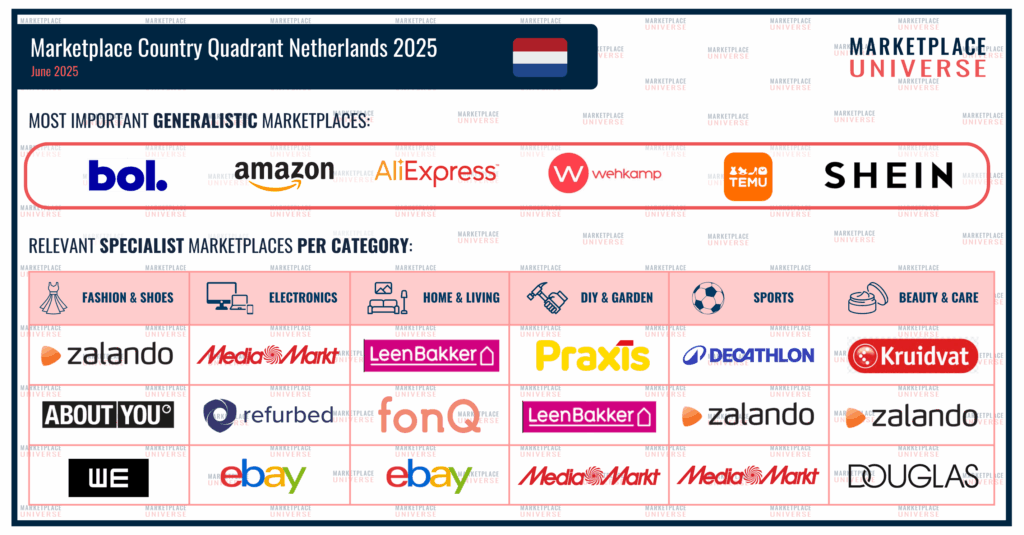
These are the most important marketplaces for selling to the NETHERLANDS (2025 Edition)
Last Update: 22.06.2025
The Netherlands is one of the most mature e-commerce markets in Europe – and yet often overlooked. With a high online penetration rate, strong local platforms, and growing international competition, it’s a fascinating market to watch. That’s why we’ve updated our Marketplace Country Quadrant Netherlands to reflect the most relevant players and trends in 2025.
The Market
The Dutch e-commerce market continues to show solid growth. In 2024, total online turnover reached €20.7 billion, a +3.1% increase year over year. With a population of 17.9 million, an average per capita e-commerce turnover of €1,238, and an online retail share of 18%, the Netherlands ranks among the most developed digital commerce markets in Europe.
The top 5 online stores in the country are: Bol, Albert Heijn, Coolblue, Shein, and Amazon – with Bol, Shein and Amazon being marketplaces.
Amazon’s traffic penetration in the Netherlands has now grown to 35%. However, local champion Bol.com still maintains its lead – for now. We discussed this ongoing battle for marketplace dominance in Episode 102 of “Let’s talk Marketplace” with Thomas Philip-Bashar from Channable, one of the key tech providers in the Dutch ecosystem.
Generalist Marketplaces
The generalist box in the quadrant has seen the biggest shake-up. Besides Bol.com and Amazon, platforms like AliExpress, Temu, and Wehkamp remain strong players.
The most notable change is the inclusion of Shein. Once a pure fashion platform, Shein now offers products in nearly every category – from home goods to beauty and electronics – making it necessary to classify the Chinese giant as a generalist in the Dutch market.
Category Leaders
Fashion 👗
- Zalando
- About You
- WeFashion
Shein would be the second-largest fashion player – but since it’s now listed among the generalists, WeFashion moves back into the quadrant.
Electronics 🔌
- MediaMarkt
- eBay
- Refurbed
While Coolblue remains the dominant retailer, it doesn’t operate a third-party marketplace model. That’s why it’s not included here.
Home & Living 🛋️
- Leen Bakker
- FonQ
- eBay
Blokker has dropped out of the quadrant after filing for insolvency last year. eBay moves in due to its continued relevance in this category.
DIY & Garden 🛠️
- Praxis
- eBay
- MediaMarkt
Sports 🏃
- Decathlon
- Zalando
- MediaMarkt
Obelink gets an honorary mention as a niche player for outdoor and camping supplies.
Beauty & Care 💄
- Kruidvat
- Douglas
- Zalando
Wehkamp, though now listed among the generalists, continues to play a significant role in this category.
Honourable Mentions
- Catawiki, a curated marketplace for collectibles and special FMCG items, remains an interesting player outside the main categories.
- Marktplaats and Vinted are strong C2C platforms, but not part of the B2C-focused quadrant.
A Market Shaped by Local Heroes
One of the most striking aspects of the Dutch e-commerce market is its unique and locally-rooted landscape. For a long time, global marketplace giants didn’t prioritize the Netherlands – and in that vacuum, strong local players flourished. Platforms like Bol.com, Wehkamp, Kruidvat, WeFashion, and Leen Bakker built solid customer bases, broad assortments, and loyal followings.
But the time when these players could act undisturbed by international competition is over. Amazon has significantly stepped up its game in the Netherlands. Temu and Shein are growing rapidly across multiple categories. And platforms like MediaMarkt are leveraging their European footprint to strengthen their marketplace operations locally. The Dutch market is still highly local – but it’s no longer insulated.
👉 Want more?
Check out our other country and category quadrants on the main overview page to stay up to date with the marketplace landscape across Europe!